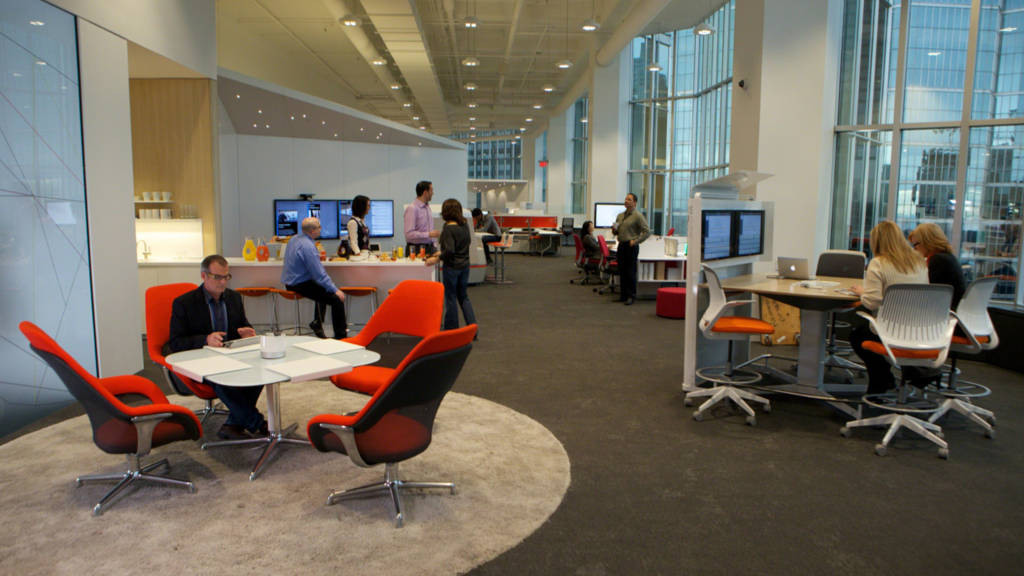
Steelcase Study Reinforcing Workplace Significance in Organizational Strategy
Steelcase Study Reinforcing Workplace Significance in Organizational Strategy,A recent study by Steelcase underscores the critical role of the workplace in organizational strategy, revealing compelling insights about employee engagement, needs, and preferences. The study highlights a substantial impact on employees who enjoy working from the office, with notable increases of 33% in engagement, 30% in connectivity, and 20% in productivity. Delving deeper, the study identifies five pivotal employee needs that drive workplace satisfaction, emphasizing the importance of accommodating these needs to foster a productive and fulfilling work environment. Additionally, the study reveals employee preferences for various types of workspaces that facilitate hybrid collaboration and individual work styles.
Insights into Employee Engagement, Needs, and Space Preferences
Driving Factors of Employee Engagement
The Steelcase study echoes the essential link between the workplace and employee engagement. Employees who work from the office demonstrate significantly higher levels of engagement, connectivity, and productivity. This finding reaffirms the concept that the physical workspace plays a crucial role in fostering a sense of community, connectivity, and purpose among employees.
Pivotal Employee Needs
The study identifies five central employee needs that are crucial for a successful workplace strategy:
Sense of Belonging: Employees seek a workspace that fosters a sense of belonging, encouraging a positive connection to the organization and their peers.
Control over Work Arrangements: Offering employees greater control over their work arrangements, such as choosing where and how they work, enhances their satisfaction and productivity.
Equal Support for In-Office and Remote Workers: Providing equitable support for both in-office and remote workers reinforces a sense of fairness and inclusivity, regardless of their physical location.
Comfort for Well-Being: A comfortable and conducive environment is essential for employees’ well-being, contributing to their overall job satisfaction and health.
Addressing Safety Concerns: Ensuring a safe and hygienic workspace is paramount, particularly in light of the ongoing health considerations related to the COVID-19 pandemic.
Workspace Preferences
The study also sheds light on employee preferences for various types of workspaces:
Hybrid Collaboration Spaces: 64% of employees highly value hybrid collaboration spaces that facilitate both in-person and virtual interactions, underscoring the need for flexible environments that support diverse communication modes.
Designated Private Spaces: 61% of employees emphasize the importance of designated private spaces that enable focused work and confidentiality.
Single-Person Enclaves for Virtual Interactions: 62% of employees prefer single-person enclaves for virtual interactions, recognizing the significance of creating undistracted spaces for video conferencing and virtual meetings.
The Steelcase study underscores the multifaceted relationship between the workplace and employee engagement, highlighting the substantial impact of the physical environment on employee satisfaction, connectivity, and productivity. By addressing pivotal employee needs and aligning workplace strategies with these requirements, organizations can create an environment that supports their workforce’s well-being and enables them to thrive. The insights into employee preferences for workspace configurations further emphasize the importance of designing versatile and flexible environments that cater to the diverse needs of modern workstyles. As organizations navigate the evolving landscape of work, the Steelcase study serves as a valuable guide for optimizing workplace strategies and cultivating a thriving workforce.
Last Updated on: Monday, August 7, 2023 10:08 am by Anu Priya | Published by: Anu Priya on Monday, August 7, 2023 10:07 am | News Categories: News, Business, GENERAL
About Us: Business Byte covers a wide range of topics, including India news, business updates, startup insights, technology trends, sports, entertainment, lifestyle, automobiles, and more, led by Editor-in-Chief Ankur Srivastava. Stay connected on Website, Facebook, Instagram, LinkedIn, X (formerly Twitter), Google News, and Whatsapp Channel.
Disclaimer: At Business Byte, we are committed to providing accurate, reliable, and thoroughly verified information, sourced from trusted media outlets. For more details, please visit our About, Disclaimer, Terms & Conditions, and Privacy Policy. If you have any questions, feedback, or concerns, feel free to contact us through email.
Contact Us: businessbyteofficial@gmail.com || ankursri983@gmail.com